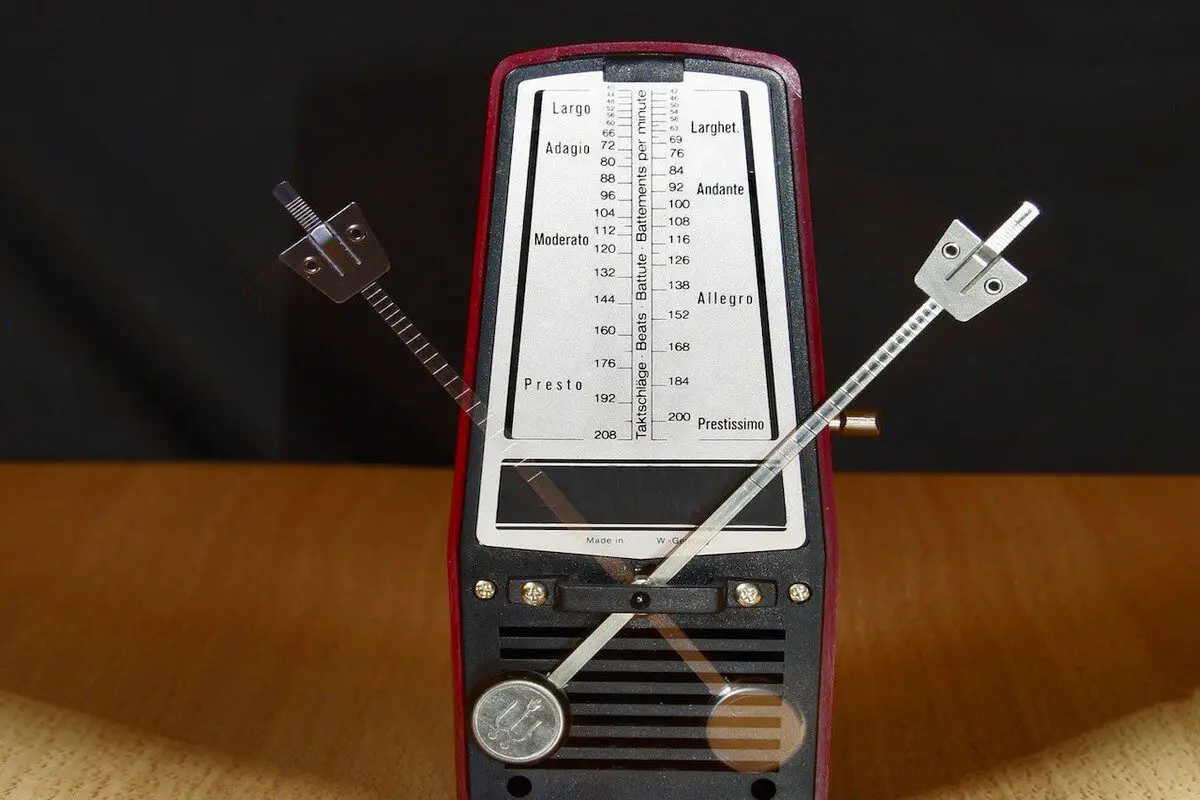In the world of music, rhythm, and timing are integral elements that breathe life into a composition. The heart of a song beats in its tempo, and to maintain this pulse, musicians turn to an invaluable tool: the metronome. But what is a metronome exactly? We’ll answer this question and explore everything you need to know about this music tool. From its definition to its main types and functionality, we’ve got you covered. So let’s start the beat and dive into the world of metronomes!
What is a metronome in music? A metronome is a device that produces regular, audible beats set to a specific tempo measured in beats per minute (BPM). It helps musicians maintain a consistent rhythm during practice or performance.
What is a metronome in music?
A metronome is a device that produces an audible click or sounds at a regular interval, typically measured in beats per minute (BPM), to help musicians maintain a steady tempo while practicing or performing.

The basic concept behind a metronome’s function is straightforward – it makes a ‘click’ or another sound at a certain rate, allowing musicians to follow along and keep their tempo consistent.
AKAI Professional MPK Mini MK3

AKAI Professional MPK Mini MK3
Where does the word metronome come from?
The word “metronome” comes from the Ancient Greek words “métron,” meaning “measure,” and “nomós,” meaning “custom” or “melody.”
What are the main types of metronomes, and how do they work?
To understand how metronomes work, let’s break down the two main kinds and how they function:
1. Mechanical Metronomes
These operate on the principle of mechanical oscillation. The classic, pyramid-shaped mechanical metronome has an adjustable weight on the end of a rod, with a pendulum mechanism at the base. When the weight is slid up the rod, it slows the tempo; when it’s slid down, it speeds up the tempo.
As the weight is moved up, it increases the moment of inertia which slows down the oscillation. The opposite happens when the weight is moved down. When you wind up a mechanical metronome and set it going, the pendulum swings back and forth, the gears inside click against a ratchet, and the metronome produces a tick-tock sound with each swing.

2. Digital Metronomes
These operate using a quartz crystal or a digital circuit to keep time accurate. When an electric current is applied to the crystal, it vibrates at a certain frequency. These vibrations are converted into an electrical signal which can then be amplified and heard as a “click” or “beep” through a speaker. The tempo on a digital metronome can be adjusted by inputting the desired beats per minute (BPM).
Additionally, many digital metronomes offer a range of sounds and options for different time signatures, as well as volume control. Some digital metronomes also have visual aids such as flashing lights or a swinging display to show the beat. Some are built into electronic tuners, and there are also metronome applications available for smartphones and computers.
How do you use a metronome in music?
To use a metronome, a musician typically sets the device to the desired BPM and then plays along with the regular clicks or sounds produced by the metronome. Here is a step-by-step guide on how to use a metronome:
- Choose the Tempo: Select the desired tempo in beats per minute (BPM) on your metronome. For a mechanical metronome, this is usually done by sliding a weight up and down a calibrated scale. For a digital metronome or metronome app, you simply input the desired BPM.
- Listen to the Beat: Turn on the metronome and listen to the beat for a few moments. This will give you a feel for the tempo you have set.
- Start Playing Your Piece: Begin to play your piece of music. Try to synchronize your playing to the beat of the metronome. The goal is to align your beats with the clicks of the metronome.
- Maintain Consistency: The main purpose of a metronome is to keep a consistent pace. Try not to rush ahead of the metronome as you play or lag behind it.
- Incrementally Increase Speed: If you’re practicing a piece that’s too difficult to play at the desired speed, you can start at a slower tempo and gradually increase the BPM as you get more comfortable. This helps to build muscle memory and precision.
Can a metronome improve your musical skills?
A metronome is a simple tool that can have a profound impact on your playing. For example, if you’re a drummer, you can use a metronome to practice your fills and improve your overall coordination. Similarly, if you’re a guitarist, you can use a metronome to practice your picking and strumming patterns, making them more precise and consistent.
By playing along with a metronome, you can learn how to lock in with the beat and create a solid foundation for your music.
By playing along with a metronome, you can learn how to lock in with the beat and create a solid foundation for your music. This can be especially useful for genres like funk, R&B, and hip-hop, where the groove is essential. By honing your rhythm-keeping skills with a metronome, you’re not just playing notes; you’re crafting a rhythmic experience that gives your music its unique character.
Advantages and disadvantages of using metronomes
Like most tools, metronomes have their distinct advantages and disadvantages, and understanding them can help us maximize their benefits and minimize their drawbacks.
Advantages of using metronomes
Now, let’s explore why metronomes might be your faithful companion during music practice. Here are the main benefits of metronomes:
- Consistent Tempo: A metronome provides a consistent beat, enabling you to maintain a steady tempo throughout your practice. It’s like having a reliable drummer who never speeds up or slows down!
- Improved Rhythm and Timing Skills: Regular metronome practice can greatly enhance your sense of rhythm and timing. It helps you understand and execute different time signatures and complex rhythmic patterns more effectively. For example, if you’re playing a piece with a tricky 3/4 or 7/8 time signature, you can set the metronome to emphasize the first beat of each measure to help you get a feel for the rhythm.
- Development of Muscle Memory: One of the key benefits of using a metronome is that it helps musicians to develop a sense of “tempo sense.” Over time, the steady beat produced by the metronome becomes ingrained in the musician’s brain and body, helping them to develop an inner sense of tempo that they can apply to their playing even when the metronome is not present.
- Enhanced Practice Efficiency: A metronome can help you focus on specific sections of your music that need improvement. By isolating and repeating these sections at a controlled speed, you can effectively work on your problem areas.
Disadvantages of using metronomes
However, it’s also important to be aware of the potential downsides of relying too much on metronomes. Here are a few considerations:
- Risk of Mechanical Playing: Over-reliance on a metronome can sometimes lead to robotic, metronomic playing. Music often requires subtle tempo fluctuations for expressive purposes, which a strict metronome beat might not allow.
- Possibility of Dependency: There’s a risk of becoming dependent on the metronome, which can inhibit the development of your internal sense of timing.
- Potential Distraction: For some, the click of a metronome can be a distraction rather than a help, especially when trying to focus on other aspects of the music, like phrasing or dynamics.
- Limited Use in Ensemble Settings: In ensemble or group settings, a metronome can’t fully replicate the organic ebb and flow of tempo that happens when humans play music together.
If you want even more tips and insights, watch this video called “How and Why to Use a Metronome” from the JustinGuitar YouTube channel.
Frequently asked questions (FAQ)
Do you still have questions about metronomes? Below are some of the most commonly asked questions.
What is the main purpose of a metronome?
Metronomes are used to keep a steady beat and help musicians maintain the correct tempo and rhythm when playing or practicing music.
Can I use a metronome for any type of music?
Yes, you can use a metronome for any type of music, including classical, jazz, rock, pop, and more. It’s a versatile tool that can benefit musicians of all genres.
Do I need to buy a physical metronome, or can I use a digital one?
Both physical and digital metronomes are available, and each has its advantages. Physical metronomes offer a classic, vintage feel, while digital metronomes offer more features and flexibility. It’s up to you to decide which one works best for you.
Conclusion
Well, folks, we’ve reached the end of our beat-filled journey! We hope you’ve learned a lot about metronomes and how they can improve your musical skills. Remember, whether you’re a beginner or a pro, using a metronome can help you develop your timing, rhythm, and sense of groove.
Did I cover everything you wanted to know? Let me know in the comments section below. I read and reply to every comment. If you found this article helpful, share it with a friend, and check out my full blog for more tips and tricks on music production. Thanks for reading, and keep the beat going!
Key takeaways
This article covered What is a metronome? Here are some key takeaways:
- A metronome is a tool that produces a steady beat, helping musicians maintain the correct tempo and rhythm when playing or practicing music.
- Using a metronome can improve your timing accuracy and sense of groove, making you a better player overall.
- Metronomes come in different types, such as mechanical and digital, each with its advantages and disadvantages.
- Using a metronome regularly can benefit musicians of all levels and genres.















